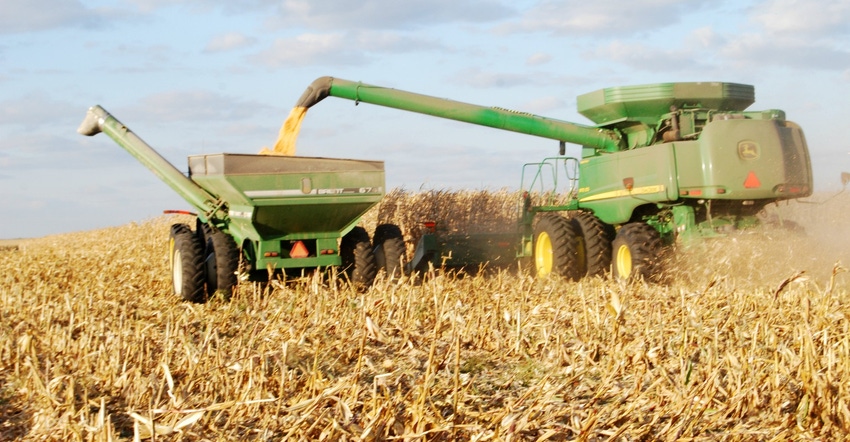November 17, 2020

Farmers across Iowa are finishing harvest. USDA’s weekly crop progress survey shows the state’s 2020 corn harvest 97% complete as of Nov. 15, and soybean harvest is 99% done. The five-year average for this date is 88% for corn in Iowa.
“Compared to the past couple years, we’ve had a really nice fall for harvest 2020,” says Paul Kassel, Iowa State University Extension agronomist at Spencer in northwest Iowa. “The dry weather allowed harvest to start a little earlier than usual as crops matured earlier. Unfortunately, we took a bit of a yield hit from that earlier-than-normal maturity for corn and beans. But we had the advantage of good grain drydown in the field for corn, so we didn’t have to use as much in-the-bin drying, which saved some costs.”
Soybeans were also too dry at harvest, as shattering loss occurred in some fields, Kassel says. Ideally, you like to harvest beans at 13% moisture content. If you are harvesting beans at 8% or 9% moisture, you’re losing 5% to 4% of the yield.
Core corn bins
“It’s been a good fall for getting anhydrous ammonia applied,” Kassel notes, “and for manure application. In recent years we’ve struggled with wet fall weather, but not in 2020.”
What about grain quality problems this fall? “Usually in a drought year like we had this summer, you can have problems with mycotoxins in corn grain,” he says. “But we haven’t had any problems in my area of the state. And I haven’t heard of any problems in other areas of Iowa either. Overall, corn quality is good this year.”
There is some storability concern with the corn that came out of the field too dry. “Those kernels are more susceptible to breakage and damage during harvesting and handling,” Kassel says. “There are more fines in that grain in the bin than usual. We encourage farmers to core their bins. That is, pull a load or two of the corn out of the center of the grain mass, which is where the fines accumulate. That will help with aeration of the stored grain when you turn the fans on.”
Recharge soil moisture
“Farmers across the state are finishing harvest,” sums up Iowa Secretary of Ag Mike Naig. “Overall, the weather this fall has been relatively favorable, and harvest progress has been running ahead compared to previous years. The short-term weather outlook in the coming week or two indicates some warmer and wetter conditions, which will be good for helping with soil moisture recharge for the 2021 growing season. “The complete weekly Iowa Crop Progress and Condition Report is available on USDA’s site at nass.usda.gov/ia.
Crop report
Above-normal rainfall, snow in Northwest Iowa and cooler temperatures only allowed Iowa farmers 4.6 days suitable for fieldwork during the week ending Nov.15, according to USDA’s National Ag Statistics Service. Fieldwork activities included harvesting corn and soybeans, baling cornstalks, applying fertilizer and manure, and performing tillage.
Topsoil moisture conditions rated 13% very short, 29% short, 57% adequate and 1% surplus. Subsoil moisture condition rated 21% very short, 34% short, 45% adequate and 0% surplus.
Only 3% of Iowa’s corn-for-grain crop remains to be harvested, almost four weeks ahead of last year at this time and just over two weeks ahead of the five-year average. Statewide, the moisture content of field corn being harvested for grain remained at 15% last week. Farmers in northwest, north-central and west-central Iowa have less than 1% of their corn for grain remaining to be harvested, while farmers in south-central Iowa still have 10% to be harvested.
Only 1% of Iowa’s soybean crop remains to be harvested, over two weeks ahead of last year and eight days ahead of average. Only scattered fields are left to be harvested. Livestock producers continue to graze cattle on cornstalks statewide.
Weather summary
“After the driest reporting period since mid-September, wetter-than-normal conditions returned to Iowa for the week ending Nov. 15,” says Justin Glisan, state climatologist with the Iowa Department of Agriculture. “Above-average totals were reported across much of the state.
“Portions of west-central Iowa observed positive departures nearing 2 inches above normal; only a small section of southeast Iowa reported drier conditions. Temperatures also varied from warmer than normal in eastern Iowa to slightly cooler than normal in the northwest. The statewide average temperature was 39 degrees F, 2.2 degrees above normal.”
Weekly precipitation totals ranged from 0.10 inch at Estherville (Emmet County) to 2.47 inches in Carroll (Carroll County). The statewide weekly average precipitation was 1.25 inches, while normal is 0.50 inch. Donnellson (Lee County) and Muscatine (Muscatine County) reported the week’s high temperature of 77 degrees on the Nov. 8, on average 23 degrees above normal. Estherville Airport (Emmet County) reported the week’s low temperature of 2 degrees on the Nov. 13, which is 23 degrees below normal. Four-inch soil temperatures as of Nov. 15 were generally in the low 40s in most of Iowa.
U.S. harvest nearly complete
Looking at the national picture, the U.S. corn and soybean harvests are nearly complete in several major producing states, according to USDA’s Nov. 16 weekly Crop Progress report.
For the 2020 U.S. corn crop, it was 95% harvested as of Nov. 15, versus an 87% five-year average for this date. Among Corn Belt states, Illinois leads with 99% of its crop harvested. Indiana has 93% harvested. The Iowa corn crop is 97% complete. Ohio farmers are only 79% finished, versus an 87% five-year average.
The U.S. soybean crop as of Nov. 15 was 96% harvested, which is ahead of the 93% five-year average. Five states are 100% harvested: Louisiana, Minnesota, Nebraska, North Dakota and South Dakota.
About the Author(s)
You May Also Like






